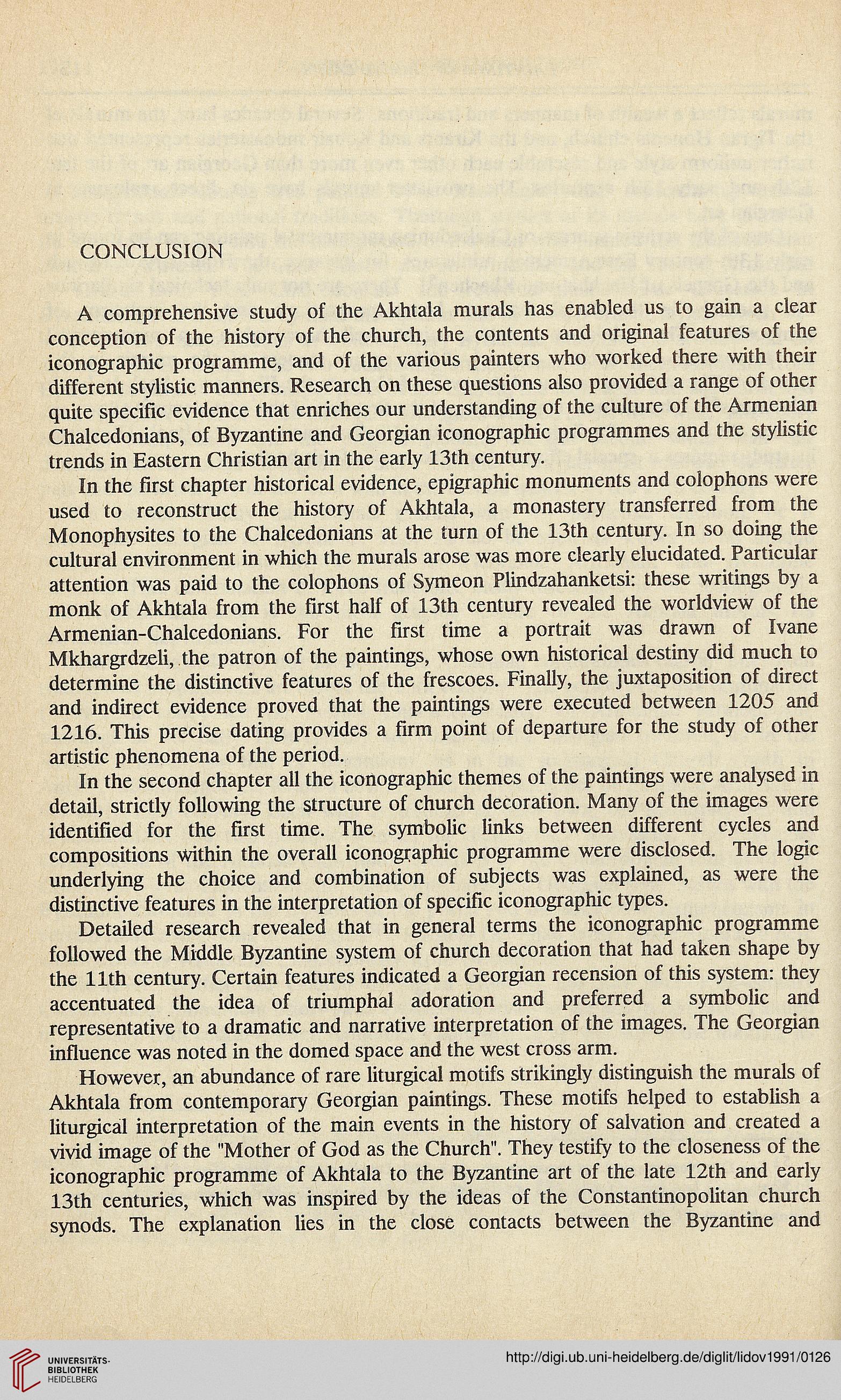CONCLUSION
A comprehensive study of the Akhtaia murals has enabled us to gain a clear
conception of the history of the church, the contents and original features of the
iconographic programme, and of the various painters who worked there with their
different stylistic manners. Research on these questions also provided a range of other
quite specific evidence that enriches our understanding of the culture of the Armenian
Chalcedonians, of Byzantine and Georgian iconographic programmes and the stylistic
trends in Eastern Christian art in the early 13th century.
In the first chapter historical evidence, epigraphic monuments and colophons were
used to reconstruct the history of Akhtaia, a monastery transferred from the
Monophysites to the Chalcedonians at the turn of the 13th century. In so doing the
cultural environment in which the murals arose was more clearly elucidated. Particular
attention was paid to the colophons of Symeon Plindzahanketsi: these writings by a
monk of Akhtaia from the first half of 13th century revealed the worldview of the
Armenian-Chalcedonians. For the first time a portrait was drawn of Ivane
Mkhargrdzeli, the patron of the paintings, whose own historical destiny did much to
determine the distinctive features of the frescoes. Finally, the juxtaposition of direct
and indirect evidence proved that the paintings were executed between 1205 and
1216. This precise dating provides a firm point of departure for the study of other
artistic phenomena of the period.
In the second chapter all the iconographic themes of the paintings were analysed in
detail, strictly following the structure of church decoration. Many of the images were
identified for the first time. The symbolic links between different cycles and
compositions within the overall iconographic programme were disclosed. The logic
underlying the choice and combination of subjects was explained, as were the
distinctive features in the interpretation of specific iconographic types.
Detailed research revealed that in general terms the iconographic programme
followed the Middle Byzantine system of church decoration that had taken shape by
the 11th century. Certain features indicated a Georgian recension of this system: they
accentuated the idea of triumphal adoration and preferred a symbolic and
representative to a dramatic and narrative interpretation of the images. The Georgian
influence was noted in the domed space and the west cross arm.
However, an abundance of rare liturgical motifs strikingly distinguish the murals of
Akhtaia from contemporary Georgian paintings. These motifs helped to establish a
liturgical interpretation of the main events in the history of salvation and created a
vivid image of the "Mother of God as the Church". They testify to the closeness of the
iconographic programme of Akhtaia to the Byzantine art of the late 12th and early
13th centuries, which was inspired by the ideas of the Constantinopolitan church
synods. The explanation lies in the close contacts between the Byzantine and
A comprehensive study of the Akhtaia murals has enabled us to gain a clear
conception of the history of the church, the contents and original features of the
iconographic programme, and of the various painters who worked there with their
different stylistic manners. Research on these questions also provided a range of other
quite specific evidence that enriches our understanding of the culture of the Armenian
Chalcedonians, of Byzantine and Georgian iconographic programmes and the stylistic
trends in Eastern Christian art in the early 13th century.
In the first chapter historical evidence, epigraphic monuments and colophons were
used to reconstruct the history of Akhtaia, a monastery transferred from the
Monophysites to the Chalcedonians at the turn of the 13th century. In so doing the
cultural environment in which the murals arose was more clearly elucidated. Particular
attention was paid to the colophons of Symeon Plindzahanketsi: these writings by a
monk of Akhtaia from the first half of 13th century revealed the worldview of the
Armenian-Chalcedonians. For the first time a portrait was drawn of Ivane
Mkhargrdzeli, the patron of the paintings, whose own historical destiny did much to
determine the distinctive features of the frescoes. Finally, the juxtaposition of direct
and indirect evidence proved that the paintings were executed between 1205 and
1216. This precise dating provides a firm point of departure for the study of other
artistic phenomena of the period.
In the second chapter all the iconographic themes of the paintings were analysed in
detail, strictly following the structure of church decoration. Many of the images were
identified for the first time. The symbolic links between different cycles and
compositions within the overall iconographic programme were disclosed. The logic
underlying the choice and combination of subjects was explained, as were the
distinctive features in the interpretation of specific iconographic types.
Detailed research revealed that in general terms the iconographic programme
followed the Middle Byzantine system of church decoration that had taken shape by
the 11th century. Certain features indicated a Georgian recension of this system: they
accentuated the idea of triumphal adoration and preferred a symbolic and
representative to a dramatic and narrative interpretation of the images. The Georgian
influence was noted in the domed space and the west cross arm.
However, an abundance of rare liturgical motifs strikingly distinguish the murals of
Akhtaia from contemporary Georgian paintings. These motifs helped to establish a
liturgical interpretation of the main events in the history of salvation and created a
vivid image of the "Mother of God as the Church". They testify to the closeness of the
iconographic programme of Akhtaia to the Byzantine art of the late 12th and early
13th centuries, which was inspired by the ideas of the Constantinopolitan church
synods. The explanation lies in the close contacts between the Byzantine and





